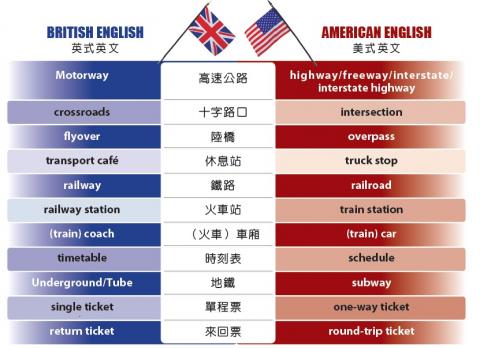The UK system of roads includes major high-speed limited-access routes known as motorways, with a network of smaller A-roads — with traffic lights or intersections — radiating out of London to other parts of England and into Scotland and Wales. In American English, the equivalents of the British motorway are the highway (sometimes with tolls), the freeway (never with tolls, hence the name) and the interstates/interstate highways extending across state lines.
There are other differences in road vocabulary between British and American English. In the UK, they talk about a crossroads, in America an intersection; in the UK a flyover for a section of road over another section of road or a railroad, called an overpass in American English; and a transport cafe in which to take a break during a long journey, known as a truck stop in American English.
In British English, the railroad is called the railway, a train station is called a railway station and a train car is called a coach. If you want to know what time the trains depart, you consult a timetable, not the schedule as in American English. And the subway is called the Underground (or the “Tube”) in London, although they do use “subway” for the system in Glasgow, Scotland.

If you only want to go one way on the railway or underground in the UK, you buy a single ticket; if you want to go and return on the railroad or subway in the US you buy a round-trip ticket. In British English, this is called a return ticket.
(Paul Cooper, Taipei Times)
英國的道路系統包括「motorways」,亦即高速行駛、車輛上路有限制的主要道路,以及較小的、以「A」編號的道路網(有交通號誌或十字路口),由倫敦向外呈輻射狀散出,通往英格蘭其他地區,以及蘇格蘭、威爾斯。相當於英國「motorway」的,在美式英文中有「highway」(有些設有收費站)、「freeway」(無收費站,因此而得名),以及跨越州邊界的「interstates」∕「interstate highways」(州際公路)等數種道路。
英、美式英文中有關道路的詞彙還有其他不同。「十字路口」在英國叫「crossroads」,在美國則稱做「intersection」;高架越過一段路或鐵路的「陸橋」,在英國叫「flyover」,美式英文稱做「overpass」;長途旅程中提供停歇處的「休息站」,在英國叫「transport cafe」(公路邊小餐館),美式英文則稱為「truck stop」(卡車停靠站)。
「鐵路」在英式英文中叫做「railway」,美式為「railroad」;「火車站」英式稱「railway station」,美式為「train station」;「火車車廂」英式稱「coach」,美式為「car」。若想知道火車何時發車,就查詢「時刻表」,英式英文叫「timetable」,美式則說「schedule」。「地鐵∕地下鐵」在美式英文叫做「subway」,倫敦的地鐵叫「Underground」(或稱「Tube」),雖然在蘇格蘭的格拉斯哥是稱做「subway」。
若搭火車或地鐵只坐單程,所買的「單程票」在英國稱「single ticket」,美式為「one-way ticket」;若亦需搭回程,則要買「來回票」,美國稱「round-trip ticket」,英式英文則叫做「return ticket」。
(台北時報林俐凱譯)

A: Early this month, Taiwanese pitcher Teng Kai-wei of the San Francisco Giants was called up from Triple-A. B: It’s just awesome. Teng became the 17th Taiwanese to be called up to the majors last year. This marks his second call-up. A: And this time, his jersey number has changed from 70 to 66. B: Who else is likely to be moved up next? A: According to the Major League Baseball (MLB) Web site, Lin Yu-min, Zhuang Chen Zhong-ao, Lee Hao-yu and Cheng Tsung-che are all rising new stars. A: 美職舊金山巨人隊本月初決定,將小聯盟3A投手鄧愷威升上大聯盟! B: 太棒了,他去年曾打進大聯盟,是台灣第17位打進大聯盟球員。 A: 上次他大聯盟背號為70號,這次背號則改為66號。 B: 還有哪些台灣選手有機會挑戰大聯盟? A:

Long before numerals and arithmetic systems developed, humans relied on tally marks to count. These simple, repeated marks — often just straight lines — are one of the earliest and most widespread methods of recording numbers. Archaeological findings suggest that humans began tallying in prehistoric times. During the Late Stone Age in Africa, humans began to carve notches onto bones to create tangible records of quantities. One of the earliest known examples is the Wolf bone, an artifact unearthed in Central Europe in 1937. This bone bears notches believed to be an early form of counting. Even more intriguing

A: In addition to Teng Kai-wei, Taiwanese infielder Cheng Tsung-che was called up temporarily to play for the Pittsburgh Pirates in early April. B: Yeah, Cheng is the 18th player in Taiwan’s baseball history to be moved up to the majors. A: Back in 2002, Chen Chin-feng became the first Taiwanese to play in the Major League Baseball (MLB), followed by Tsao Chin-hui, Wang Chien-ming, Kuo Hung-chih, Hu Chin-lung and Lin Che-hsuan. B: Those pioneers were later joined by Lo Chia-jen, C.C. Lee, Ni Fu-te, Chen Wei-yin, Wang Wei-chung, Hu Chih-wei, Tseng Jen-ho, Lin Tzu-wei, Huang Wei-chieh, Yu Chang,

Continued from yesterday(延續自昨日) https://www.taipeitimes.com/News/lang In many Western countries, the most common form of tally marks employs a five-bar gate structure: four vertical lines followed by a diagonal slash. To form this group, one begins by drawing four parallel vertical lines, each representing one. For the fifth, draw a diagonal line across the existing four. This diagonal stroke effectively creates a distinct group of five. To continue counting, just initiate a new cycle in the same manner. A set of five tallies combined with a single vertical line next to it represents the number six. Across many Asian countries, the Chinese character